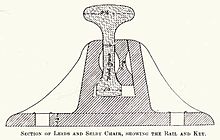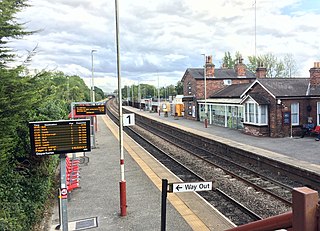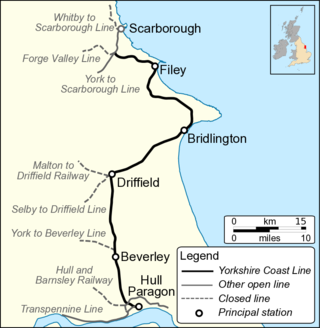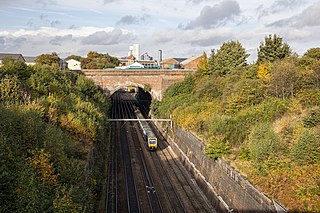The Leeds and Selby Railway Company (1830–1844)
Background
By 1830 Leeds had long been an important town, having become prosperous initially through the manufacture of woollen cloth. The Leeds and Liverpool Canal was complete and the Aire and Calder Navigation connected Leeds to the Ouse, and thus to the North Sea and beyond. [1] Selby had grown in importance as a port since the construction of the Selby Canal and had become an important inland east coast port for coastal and foreign trade.
As early as 1814 [note 1] the Leeds Mercury had printed letters promoting the idea of a railway from Leeds to Selby. [3]
The Leeds and Hull Railway
The Leeds and Hull Railroad Company was formed in 1824 in Leeds. George Stephenson was appointed as engineer, and he directed Joseph Locke to survey the line. [4]
Stephenson recommended a double track railway, operated by locomotives at a speed of 8 mph (13 km/h). [5] The hills on the route out of Leeds were to have three inclined planes to be worked by three stationary engines. The remainder of the line was to be very nearly level. [6]
The company was one of a number of contemporary projects aimed at linking the east and west sides of northern England, such as the Newcastle and Carlisle Railway (act of Parliament 1829) and the Liverpool and Manchester Railway (act of Parliament 1826). The Manchester and Leeds Railroad Company was formed in 1825, and would have completed the Lancashire to Yorkshire link. [4] Representatives of the company were present at the opening of the Stockton and Darlington Railway in 1825. [7] Of these schemes the Leeds and Hull, and the Manchester and Leeds were not immediately acted upon, in part due to the stock market crash of 1825. [8] [note 2] The Leeds and Hull scheme stagnated, and in the meantime the Knottingley and Goole Canal (an extension of the Aire and Calder Navigation) opened in 1826 bringing the village of Goole from obscurity, and turning it into a viable transhipment port for Europe.
The growth of Goole as a port to rival Hull was sufficient to spur the Hull-based shareholders of the Leeds and Hull railway into action; at the end of 1828 they motioned that the railway should be built as far as Selby, with the remainder of the journey to Hull being made by steam packet, most importantly, bypassing Goole. The shareholders passed the proposal at a general meeting in Leeds on 20 March 1829, and the Leeds and Selby Railway Company was formed. [8]
Formation of the Leeds and Selby Railway Company
Leeds and Selby Railway (1834) | |||||||||||||||||||||||||||||||||||||||||||||||||||||||||||||||||||||||||||||||||||||||||||
|---|---|---|---|---|---|---|---|---|---|---|---|---|---|---|---|---|---|---|---|---|---|---|---|---|---|---|---|---|---|---|---|---|---|---|---|---|---|---|---|---|---|---|---|---|---|---|---|---|---|---|---|---|---|---|---|---|---|---|---|---|---|---|---|---|---|---|---|---|---|---|---|---|---|---|---|---|---|---|---|---|---|---|---|---|---|---|---|---|---|---|---|
| |||||||||||||||||||||||||||||||||||||||||||||||||||||||||||||||||||||||||||||||||||||||||||
The Leeds and Hull railway scheme of 1824 was revived as a shortened line from Leeds to Selby and was resurveyed by James Walker in 1829; [9] Benjamin Gott, one of the line's promoters and a wool and cloth magnate thought the inclined planes would be a disadvantage. [6]
James Walker reported that the stationary engines could be abandoned, and tunnels and cuttings built in their place. He expected that the additional cost of their construction would be offset by use of the stone elsewhere on the railway and by its sale. The railway would also be of use for the transportation of coal and stone from quarries and mines near the line, such as the Huddlestone quarry. Additionally he suggested that the route of the railway could also be used for the piping of clean water to Leeds. As to the route of the railway, he suggested resiting the Leeds terminus at cheaper and less-developed land around Marsh Lane instead of at Far Bank. The resurveyed line was also deviated to the north away from the river bank, to avoid the objections of the Aire and Calder Undertakers; the more northern path would require passing Richmond Hill requiring either stationary engines or a tunnel; Walker recommended the latter. Outside Leeds, minor deviations were made in order for the line to cross the north–south turnpikes using bridges. At Selby, the new plan sited the station further south than the original, which had been sited next to the road bridge, with the intention of crossing the River Ouse by widening this bridge; with the line no longer going to Hull but terminating at Selby a site with more space for wharves and jetties was required. He recommended a double track line, with sufficient land acquired for a four track line. [10]
Much of the line was to be built on land belonging to the shareholders, including Edward Robert Petre who owned land in Selby, and Richard Oliver Gascoigne (who later had built the Aberford Railway). Walker's alterations to Stephenson's original plan were accepted unaltered and put before Parliament. [11]
Despite strong opposition from the Aire and Calder Navigation, which had a practical monopoly on transportation in the area, a bill was passed in Parliament on 29 May 1830 allowing construction of the line. The company was allowed to raise a total of £300,000 in shares and loans. [12] [13] [note 3] The company's directors were James Audus, Edward Baines, Thomas Davison Bland, John Broadley, Richard Oliver Gascoigne, Benjamin Gott, Robert Harrison, John Marshall, John Cowham Parker, the Hon. Edward Robert Petrie, John Scholefield and John Wilson. Samuel Wilks Waud was the first company chairman. [14]
Construction, infrastructure and rolling stock
Two contractors, Messrs. Nowell & Sons and Messrs. Hamer & Pratt, were chosen to carry out the construction of the line. Nowell began construction of the 2 miles (3.2 km) out of Leeds on 1 October 1830, [note 4] and Hamer & Pratt began work in February 1831 on the remaining 18 miles (29 km) to Selby. [14]
The primary engineering feature of the line was the Richmond Hill Tunnel through Richmond Hill, Leeds. It was 700 yards (640 m) long, with its western entrance at 8 chains (160 m) from the Leeds terminus. The tunnel's cross section was that of a horseshoe arch, 22 ft (6.7 m) at its widest, and 17 ft (5.2 m) high from the level of the rails. The construction of the tunnel required the sinking of three shafts, subsequently retained for ventilation. [15] [16] Excavation of the tunnel yielded mostly shale and coal, with the remaining third being stone which was used as foundations for other parts of the line. The arch was lined with two courses of brickwork, lengthways to a thickness of 20 inches. In some places three courses were used, depending on the strength of the surrounding ground. Volcanic matter was used in the mortar, to obtain a quick-setting and strong cement. [17] The entrances of the tunnel were faced with stone. [18] This would be the world's longest railway tunnel at opening and the first through which passengers would be hauled by locomotives [19] and there were once reflectors at the base of the shafts, designed to reflect light onto the whitewashed walls of the tunnel. [20] The shafts were found to be useful for ventilation, but the experiment with illuminating the interior with reflect light was of limited utility to passengers; lamps were provided to light the carriages. [16] Despite the efforts, an early passenger reported that on entering the tunnel:
We were immediately enveloped in total darkness, and every one of the carriages filled with smoke and steam to a most annoying degree

As built, the line had 43 bridges and around 16 level crossings. [23] Ballast was of stone chips; the rails were held in place by keys lodged into iron chairs which rested on and were fixed to stone blocks or larch sleepers. On some parts of the line, a ladder track arrangement of sleepers was used, with longitudinal stone sleepers of 3 ft (0.91 m) held in gauge by transverse cast-iron rods. T or bar-shaped malleable iron rails of 35 lb/yd (17.4 kg/m) were initially used, within a few years 42 lb/yd (20.8 kg/m) rails were being introduced. [23] [24]
Cuttings and embankments were built to keep the gradient of the line to a minimum. The deepest cutting was 43 ft (13 m), the highest embankment 54 ft (16 m). [25] Both embankments and cuttings had stone retaining walls at the base, at an angle of 67.5° to the horizontal, which reduced the overall width of the earthworks. The line was built as a double-track railway. [23]
Route and stations
After 8 chains (160 m) of level track outside the Leeds terminus, the line generally ascended for a distance of 4 miles 32 chains (4.40 miles, 7.08 km) at a maximum slope of 1 in 160; it was then level for 2 miles 61 chains (2.76 miles, 4.45 km) after which it generally descended eastwards towards Selby for 6 miles 6 chains (6.08 miles, 9.78 km) with a maximum rate of descent of 1 in 137. The final 6 miles 41 chains (6.51 miles, 10.48 km) to Selby was practically level with a rate of descent of only 1 in 3785. The highest point was 132 ft (40 m) above the Leeds terminus, with the whole line having a net descent of 100 ft (30.5 m) towards Selby. [23]
The Marsh Lane terminus in Leeds, and the station at Selby, were early examples of what would become 'railway architecture': both were long rectangular sheds, with wooden trussed roofs, supported internally on cast iron columns. [26] The stations served for both passenger and freight, with additional tracks external to the sheds for coal; there was no platform for passengers. Both stations had coal depots, the Leeds station contained the facilities for maintenance of engines and wagons. [27] [28] The rear of the Selby station backed onto the Ouse, across a road (Ousegate) from jetties that would allow a continuation of the journey to Hull. [29]
After the station at Marsh Lane in Leeds were stations at Cross Gates, Garforth, Roman Road, Micklefield, Milford, and Hambleton. [30]
Locomotives
The original engines were of the lightweight four-wheeled "Bury" type [31] from Edward Bury of Liverpool. They were shown to lack traction sufficient for the line, and were sold. Replacements were obtained from Fenton, Murray and Jackson of (Leeds) and from Kirtley & Co. of Warrington. [32]
- Locomotive list
- Notes
- YNMR = York and North Midland Railway
- NER = North Eastern Railway
- The names and numbers of the Kirtley locomotives may have been transposed
Rolling stock
There were first and second-class carriages, horse boxes and wagons, including privately owned wagons. [34]
Opening and operation
By 22 September 1834, a single complete line of track had been built, and the railway was officially opened. A train of ten carriages, hauled by the locomotive "Nelson", set out from Marsh Lane station in Leeds at 6.30 am. To the embarrassment or amusement of those present, the locomotive got into difficulty on the incline at the tunnel. The wheels began to slip on wet rails, and despite the application of ash on the rails, initial progress was no better than walking pace. Once the high point of the line was reached, better progress was made: at Garforth, on a stretch of track falling 1 in 180 a speed of 20 mph (32 km/h) was attained. Selby was reached before 9 am. The return journey took 1 hour and sixteen minutes. On the 23rd, two trains were run each way, with a better timing of 1 hour and five minutes from Leeds to Selby. [35] [36]
Both lines of track were complete by 15 December, when the railway began to take goods traffic. [37]
In The Railways of Britain and Ireland practically described and illustrated, Francis Whishaw ascribed the poor financial performance of the railway to the management of the line; after six years of existence, the railway was returning a profit, but the average dividend on a £100 share over 1837 to 1840 was a meagre one pound, sixteen shillings and nine pence. [38]
As a result of the opening of the line, the Aire and Calder Navigation had to make considerable reductions in their charges. [39] Previously, that company's monopoly had resulted in a dividend on shares of over 200%. [40]
Connections with other railway lines
York and North Midland Railway
York Junction | |||||||||||||||||||||||||||||||||||||||||||||||||||||||||||||||||
|---|---|---|---|---|---|---|---|---|---|---|---|---|---|---|---|---|---|---|---|---|---|---|---|---|---|---|---|---|---|---|---|---|---|---|---|---|---|---|---|---|---|---|---|---|---|---|---|---|---|---|---|---|---|---|---|---|---|---|---|---|---|---|---|---|---|
| |||||||||||||||||||||||||||||||||||||||||||||||||||||||||||||||||
On 29 May 1839 the first section of George Hudson's York and North Midland Railway opened. It ran from York to a point just to the east of Milford station where a short chord connected it to the Leeds and Selby Railway. The line was extended southwards to Burton Salmon by 11 May 1840; and that line connected by another short chord to the junction with the Leeds and Selby on 9 November 1840. [41]
East of the junction was a station called York Junction. [41] [note 5]
Hull and Selby Railway
The original Leeds to Hull plan was completed in 1840 with the construction of a line running almost directly east from Selby to Hull. A bascule bridge was constructed across the Ouse at Selby, just north of the jetties at the rear of the original Selby station. A new station to the west was constructed, and the old station became a goods shed. [42] [43]
Aberford Railway
The Aberford railway was a private railway built during the same period as the Leeds and Selby Railway by the Gascoigne family. It ran from Aberford and connected at Garforth. It was built primarily to carry coal from the Gascoigne's coal mines but also carried passengers. It closed in 1924.

















